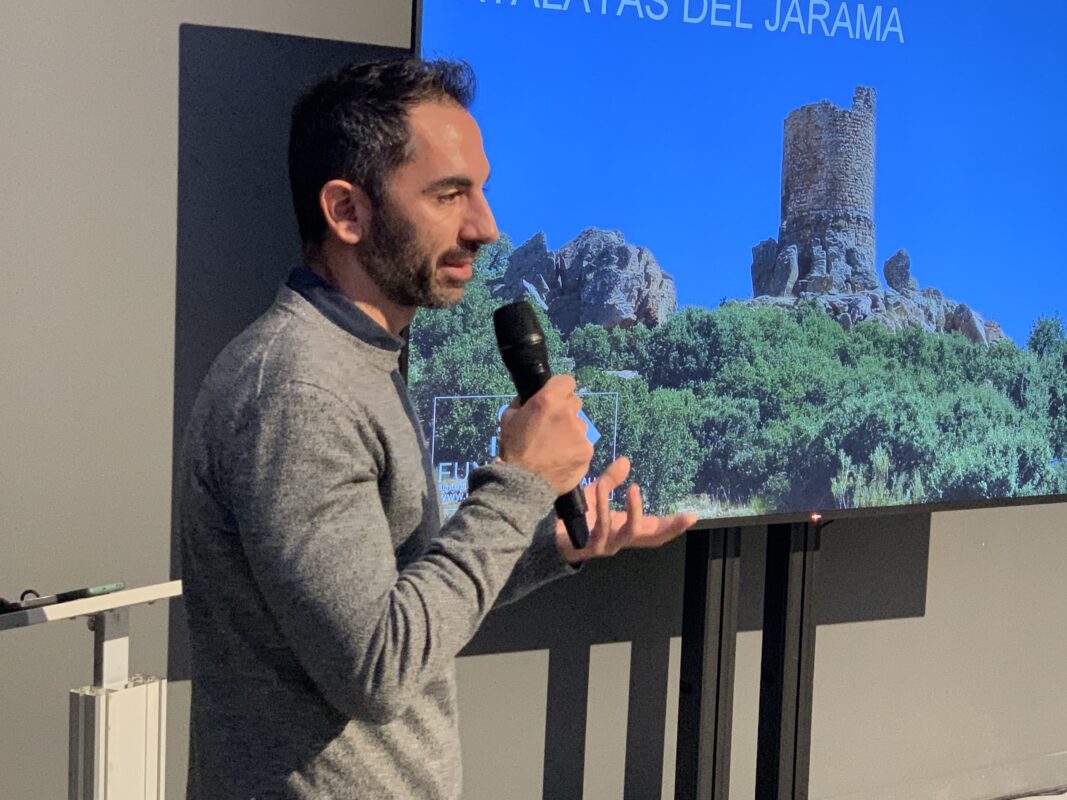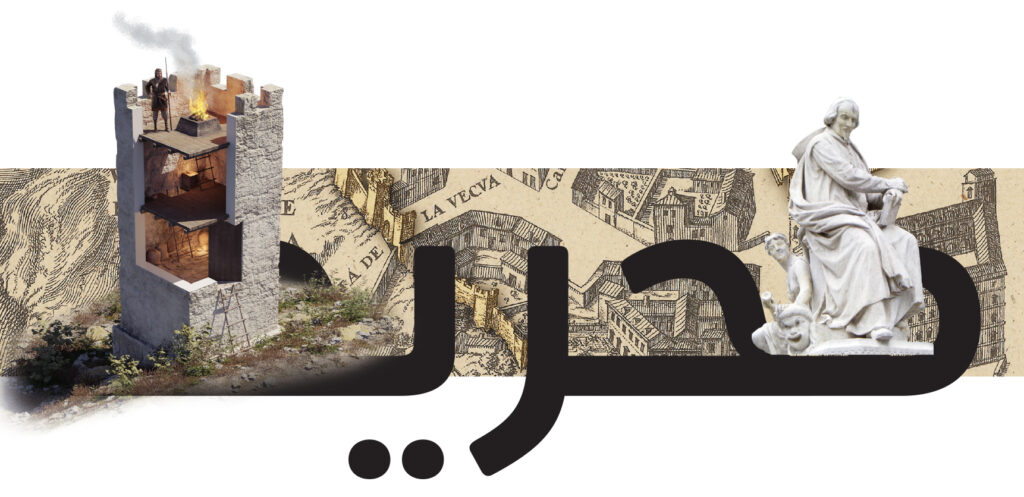Article author: FUNCI
Date of publication of the article: 05/02/2024
Year of publication: 2024
Article theme: Al-Andalus, Arab, Archaeology, Architecture, Art, History, Madrid, Sustainability, Tourism.
On January 25, the Center for Studies on Islamic Madrid (CEMI), created by de Islamic Culture Foundation, participated in FITUR, in collaboration with the Madrid City Council. The presentation “All Andalus. A tour of Islamic Madrid inside and outside its territory” was presented at noon.
The “Interactive Map” of Islamic Madrid beyond its borders

In the previous edition, the “Interactive Map” of Islamic Madrid, an online map that catalogues the Andalusi heritage in the capital of Madrid. The map shows the most representative points of this legacy on the cartography. In addition, each of these landmarks is accompanied by a file based on a referenced bibliography. It describes the element and its state of conservation.
The aim is to create not only a tool for consultation, but also for reporting. This way, in case of need, it can be presented to the relevant government bodies and request actions for its proper preservation.
The map combines the most traditional theoretical knowledge with technological innovation to offer an interactive resource that is easy to access and very attractive. Thanks to geolocation, one can visit the spaces autonomously. It also shows the area of the medieval walled enclosures (from the Andalusi and Late Medieval Ages), the Moorish quarters and the Islamic cemetery, among others. These areas are superimposed on the backdrop which, by default, is the magnificent map of the well-known cartographer Pedro Teixeira (1656), where it is still possible to observe many of the remains of the medieval and modern world that has disappeared today. The base plan, for better functionality, can also be changed either by the Madrid street map or by the satellite view, which offers a vision of where these points were located throughout three different historical moments.
Regarding this missing heritage, the Centre for Studies on Islamic Madrid has sought to restore the vision and memory of some of the Islamic remains. This is the case of the taifa watchtower (11th century), whose remains are underground, in a private parking lot, at the mercy of vehicles and pollution. Its original appearance has been virtually reconstructed through collaboration with specialists in the area and the work of the company 3DStoa, a leading company in the application of technology to cultural heritage.
Due to the great reception it received, the possibility of making it available in more than one language was considered. CEMI is pleased to announce that the map can now be enjoyed in both English and Arabic. This would not have been possible without the patronage of Imar Engineering Consultants. This increases the accessibility of the platform and connects with places far away from Madrid, but twinned by a common culture. We are at a time when the expansion of tourism from Arabic-speaking countries is booming, which presents a unique opportunity to make our heritage known to an increasing number of visitors.
Translation as an intercultural bridge: the Sheikh Hamad Award 2023
As a result of this and other work, the Islamic Culture Foundation (FUNCI), the organization to which the center belongs, has been awarded the Sheikh Hamad Prize for Translation and International Understanding (SHATIU), in the “Spanish Language Achievements” category, in its ninth edition. The award aims to strengthen the presence of the Arabic language and culture at a global level as a bridge for intercultural dialogue. FUNCI was awarded along with other important institutions such as the Toledo School of Translators and the Colegio de México.
The award is intended to honor translators and translation centers in recognition of their role in strengthening the bonds of friendship and cooperation among the peoples and nations of the world. On the other hand, it rewards merit and excellence in their creative work.
The award also aims to foster understanding and dialogue, as well as promote Arab and Islamic culture.
A unique visit: the “Andalusi Itinerary” at the Royal Botanic Garden
this spring will be the inauguration of the “Itinerario andalusí”, an initiative of FUNCI in collaboration with the Royal Botanical Garden-CSIC (located in Madrid), which was born from the desire to raise awareness of the vast natural heritage of al-Andalus. This tour is an invitation to travel to the Iberian Peninsula from the 8th to the 15th centuries through a selection of fifteen plants that grow in the Botanical Garden. The explanations can be read in Spanish, Arabic and English on the websites of both institutions as well as on the panels that indicate, in situ, the points of the itinerary.
It is presented as a visual and olfactory journey through time and space for eight centuries of history and intercultural coexistence. The Imazighen and Arab troops that crossed the Strait of Gibraltar in 711 inaugurated not only a historical period in the Iberian Peninsula, called “al-Andalus”, but also an era of great cultural and scientific splendour. Agriculture and botany were greatly enriched with new species of ornamental, aromatic, medicinal, culinary and food plants, among many others. After their introduction and acclimatisation on peninsular soil, many of these species are nowadays naturalised.
The Imazighen and Arab troops that crossed the Strait of Gibraltar in 711 inaugurated not only a historical period in the Iberian Peninsula, called “al-Andalus”, but also an era of great cultural and scientific splendour.
“All Andalus. Digital Inventory of Cultural Heritage”

On the other hand, the great lack of knowledge about the Islamic legacy in the peninsula and the dispersion of this heritage has led to the creation of “All Andalus. Digital Inventory of Cultural Heritage”. It is a collaborative tool for online consultation of information on cultural assets linked to the Andalusi world and its survival on the Iberian Peninsula. In an initial phase, elements from the Community of Madrid have been collected, but it is planned to progressively enrich the inventory.
It is a collaborative tool for online consultation of information on cultural assets linked to the Andalusi world and its survival on the Iberian Peninsula.
This is a very ambitious project, in which cooperation is a fundamental pillar. Working in a network not only allows access to information that we would not otherwise be able to obtain, but also implies that both institutions and individuals are involved in the revaluation and consequent preservation of the Islamic heritage. A form has been created on the website so that users can contribute remotely by providing data on an element to be catalogued.
Together with the inventory, a series of informative booklets will be launched, containing explanations of some of the most relevant types of goods of the Islamic culture, such as the baths. Each booklet will be accompanied by photographs, illustrations, and/or a 3D reconstruction; an initiative coherent with our efforts to apply innovative tools to our work.
New guided tours: tools for territorial development
This work of compiling information and research is most directly reflected in the guided tours offered by the study centre, whose catalogue is becoming increasingly extensive and diverse. On the one hand, “The Other Barrio de las Letras: Aljamiada literature, the Siglo de Oro and the Moors”, was presented, a literary itinerary that revolves around the presence of the Islamic and its border and mixed-race derivatives in Madrid in the 16th and 17th centuries. On the other hand, the CEMI, together with the dissemination project Arab Madrid, is currently working on another project: «Watchtowers of Jarama». The aim of this project is to create a tourist route through several villages in the middle Jarama Valley and to weave local collaboration networks that involve themselves in the design of a common strategy, based on their cultural heritage, to promote the sustainable development of these municipalities.

By way of conclusion
In short, the Islamic Culture Foundation works transversally to promote a space for intercultural dialogue; to this end, the Foundation makes use of its various arms, such as the Centre for Studies on Islamic Madrid (CEMI). Through the preservation, research, and dissemination of heritage, it seeks to raise awareness of the contribution of Islamic civilisation to our culture, as an indissoluble part of our identity, in order to improve coexistence in today’s Madrid. But what does this mean?
Among other things, the CEMI aims to professionalise the information and tourism sector. To achieve this goal, the centre offers users complex, rigorous, and quality products that have a positive economic, social, and cultural impact on the territory, in addition to promoting a respectful and sustainable treatment of the environment.


